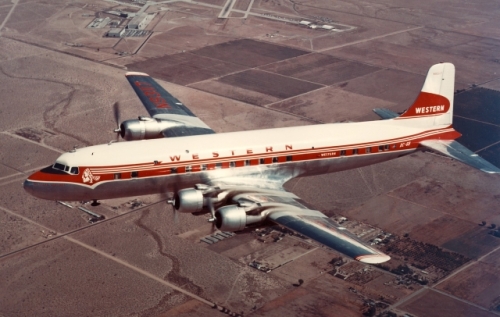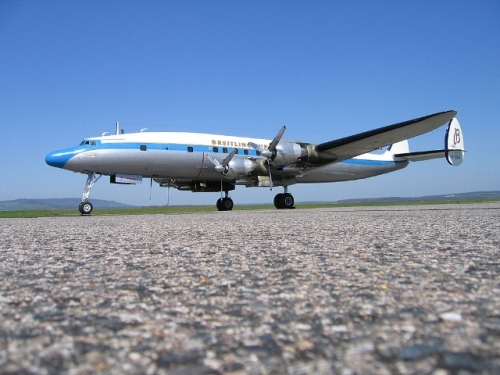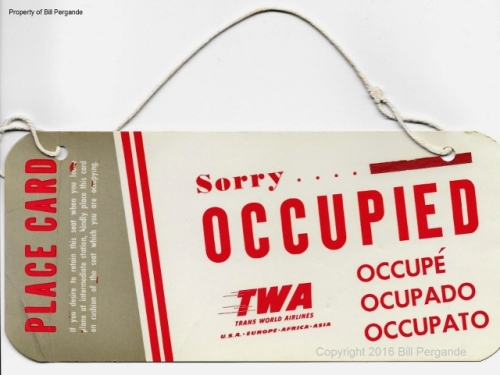In a recent blog post about the demise of the Puget Sound Ferry, Kalakala, I wrote, “Kalakala captured the imagination of many, including mine; it was unique, remarkable…. We no longer ride in ornate Pullman cars drawn by streamlined locomotives or fly to Hawaii in Pan Am clipper ships or cruise shady streets in convertible Duesenberg motorcars. No, today we move faster, if less stylishly.”
That inspired longtime reader, LaBoheme, to write some observations about the changing nature of travel. He writes:
Your remark got me thinking about commercial aviation in days gone by. My mother recently told me that I started flying at age 3 months, which would place my first flight in 1951. My dad worked for an airline, which allowed all family members to fly for free. I flew frequently up to age 12.
The 1950s saw not only a major expansion of commercial air travel, but also major developments in aircraft design. As a frequent traveler during this time, I witnessed those developments firsthand. I still remember flying on old piston-engine powered airplanes with two engines like the DC-3 …

… and four engines, the DC-6.

I also flew on the DC-7, as well as a 2-engine Martin 4-0-4 like this one:

One of the most distinctive aircraft I traveled in was the Lockheed Constellation, the first commercial airliner to cross the U.S. non-stop.

The design of the “Connie,” the largest commercial aircraft of its time, was unique. It had a tri-tail assembly (3 rudders). The Constellation was the flagship of Trans World Airlines (TWA), an airline that no longer exists. Throughout the 1950s we flew the TWA Connie from Washington, D.C., where we lived, to northern California, where my grandparents lived. I still have a TWA seat placard from those trips.

We also flew Capital Airlines, the airline that my dad worked for before it merged with United Airlines in 1962. Here’s a ticket from 1956:

My favorite Capital airplane was the Viscount. Here are two promotional postcards of the Viscount handed out by the airline:


The Viscount was a transitional airplane between piston-engine power and jet power, and combined features of both in its use of turbine-driven engines manufactured by Rolls-Royce. Thus, the Viscount engines did have propellers like the older piston-engine planes, but the Viscount’s engine power came from turbines like later jet engines. In fact, its engine was called the “jet-prop” or “turbo-prop.”
The ride in the Viscount was considerably smoother and quieter than in its predecessor piston-engine aircraft. In the Connie, those four massive Pratt & Whitney engines transferred all of their vibrating power and noise right into the cabin — talk about feeling your teeth rattle and your ears burst! But the Viscount was simply whisper-smooth — a creature of pure beauty, comfort, and elegance, with large oval windows for good viewing. I still remember watching the turbo-prop engines start and the propellers turn over: NO vibration; just a slight whistle sound. In the late 1950s and early 1960s, I then transitioned to jet travel with the Boeing 707, the first commercial jet.
In those early days of commercial air travel, the airlines would give promotional items to young passengers, including decals, pens and pencils with the airline’s logo on them, brochures about the plane, postcards, and small plastic models of planes. I still have several, including this one of a Constellation, with a pencil to indicate scale, along with a Capital Airlines Viscount coaster:

It was another era of more stylish and – if I may say – considerate travel, reflecting perhaps a simpler world. Slower, but with class. I’m glad we can cover the distances faster now, but I miss the style.
Thanks, La Boheme.
If any other readers have a reminiscence of classy travel — vintage or new, we’d be glad to have your comments.
© Bill Pergande, Brad Nixon 2016, 2017
DC-3 photo © Towpilot used under Creative Commons License for image located HERE.
Martin 4-0-4 photo © RuthAS used under Creative Commons License for image located HERE.
Lockheed Constellation photo © Oschiti used under Creative Commons License for image located HERE.
Great Post
LikeLike
By: mukul chand on January 8, 2016
at 5:45 am
Thank you. A pleasure to have you visit. Congrats on your own blog with a vast amount of info and photos on plants and trees of India.
LikeLiked by 1 person
By: Brad Nixon on January 8, 2016
at 9:29 am
Welcome. Thanks for taking time out to check out and leave your lovely views on my blog.
LikeLike
By: mukul chand on January 8, 2016
at 7:10 pm
A charming memoir, LaBoheme. Thank you. I enjoyed the memorabilia too. The boarding pass reminded me of vintage menus and other paper items from another era of cruise ship travel.
LikeLike
By: Marcy Vincent on January 8, 2016
at 7:34 am